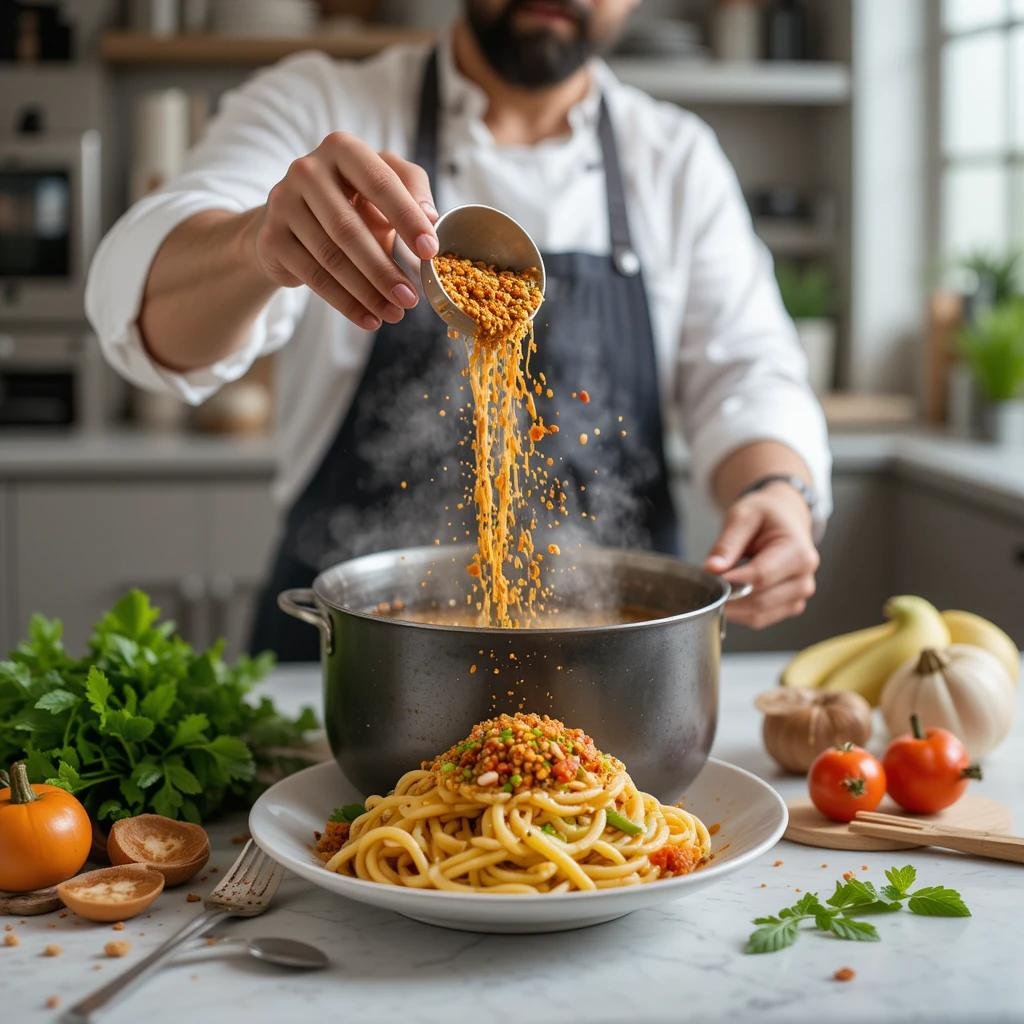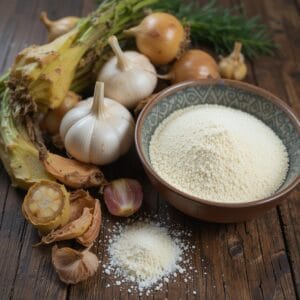Sinigang is the magic dust that has simplified the art of cooking one of the most beloved Filipino dishes. But what Is Sinigang Mix made of exactly? If you’ve ever savored that tangy, comforting bowl of sinigang and wondered what goes into making that signature flavor, you’re in the right place. Let’s dive into the ingredients, history, and how this flavorful mix has become a kitchen staple.
Table of Contents
Sinigang mix is a powdered seasoning mix specifically created to capture the essence of sinigang. For anyone unfamiliar, sinigang is a Filipino sour soup or stew, often loaded with vegetables and a choice of meat or seafood. What sets it apart is its unique tangy flavor profile, usually achieved with tamarind as the base.
Sinigang mix takes that traditional preparation and condenses it into an easy-to-use packet. Just tear one open, sprinkle it into your pot, and voilà—you’ve got sinigang on the table with half the effort! But is it really that simple? Let’s unravel the story behind this culinary lifesaver.
The Essence of Filipino Cuisine: Understanding Sinigang
Sinigang is more than just a dish; it’s a celebration of Filipino heritage. Its bold, sour taste mirrors the Filipino spirit—resilient, adaptable, and always ready to make the most out of simple ingredients.
Historical Background of Sinigang
The roots of sinigang go deep into the Philippines’ culinary traditions. Historians believe it originated centuries ago, long before refrigeration, when tamarind was used to preserve food and add flavor. Over time, families experimented with different souring agents like guava, kamias (bilimbi), and calamansi, depending on what was available.
When sinigang mix entered the scene, it revolutionized the way this dish was prepared. No more pounding tamarind or squeezing calamansi juice—just add a spoonful of the mix and you’re good to go. It’s convenience wrapped in a little packet!
How Sinigang Mix Revolutionized Home Cooking
Sinigang mix brought the sour taste of tradition into modern kitchens. Many busy families have embraced it as a shortcut that doesn’t compromise on flavor. Whether you’re a seasoned home cook or a beginner trying to recreate grandma’s sinigang, this mix simplifies things while keeping the soul of the dish intact.
“Sinigang mix is like a bridge between tradition and modernity—it honors the past while making the present more convenient.”
Key Ingredients
You might think sinigang mix is just tamarind powder, but there’s more to it than meets the eye. Its formulation ensures consistency and that lip-puckering tang we all love.
Tamarind as the Heart of Sinigang Mix
The main ingredient of sinigang mix is, of course, tamarind. This tropical fruit provides the sour punch synonymous with the dish. Tamarind pulp is dried and powdered to make it shelf-stable, ensuring you can enjoy sinigang year-round, no matter where you are.
Tamarind isn’t just about the sourness—it also adds a hint of fruity sweetness that balances the dish. It’s like the secret ingredient that keeps everyone coming back for seconds (or thirds!).
Complementary Ingredients in Sinigang Mix
Sinigang mix doesn’t stop at tamarind. It usually includes a blend of spices, such as onion and garlic powder, to enhance the flavor. MSG is often added to boost umami, while salt provides seasoning. Some brands also include powdered fish or shrimp to add depth to the broth.
However, not all mixes are created equal. Some opt for natural ingredients, while others rely on artificial flavoring. Reading the label is key to finding one that aligns with your taste and health preferences.
Natural vs. Artificial Components
One debate surrounding sinigang mix is the use of artificial ingredients. Purists argue that nothing beats the taste of fresh tamarind, while others appreciate the mix’s convenience. Many brands have begun offering “natural” or “organic” versions, using real tamarind extract and fewer additives.
“Whether you’re team natural or team convenient, sinigang mix proves there’s no one way to enjoy this beloved dish.”
Variations of Sinigang Mix
Just as there are different ways to prepare sinigang, there are also several types of sinigang mix available. Each one caters to different preferences and dietary needs.
Tamarind-Based Mixes
The most popular version is, of course, tamarind-based. This is the classic sour mix everyone knows and loves. It’s versatile enough to pair with shrimp, fish, or even vegetarian sinigang.
Guava and Other Fruit-Based Sinigang Mixes
Some adventurous cooks like to experiment with guava or green mango-based sinigang mixes. These provide a milder, fruitier sourness compared to tamarind. It’s perfect for those who want a different twist on the classic.
Low-Sodium and Healthier Alternatives
For health-conscious cooks, low-sodium sinigang mixes have become a hit. These options reduce salt content without skimping on flavor. There are also organic mixes made with natural ingredients for those steering clear of preservatives.
The Production Process
How does a simple fruit like tamarind get transformed into the powdery sinigang mix we find on grocery shelves?
Sourcing the Ingredients
The journey begins with sourcing tamarind and other raw materials. Quality matters here—ripe tamarind ensures a rich, tangy flavor. Some brands also prioritize locally sourced ingredients to support farmers.
Drying and Powdering the Base
Once harvested, tamarind is processed to remove its seeds and fibers. The pulp is dried and ground into a fine powder. This is the base of most sinigang mixes. Additional spices and seasonings are blended in during this stage.
Packaging for Freshness
Finally, the mix is packed into airtight sachets to preserve its flavor. Modern packaging technology ensures the mix stays fresh for months, making it a pantry essential for Filipino families worldwide.
Nutritional Profile
Ever wondered if sinigang mix is good for you? While it’s definitely tasty, let’s look at the nutritional side of things.
Benefits of Tamarind and Other Ingredients
Tamarind is packed with vitamins and antioxidants. It’s a good source of vitamin C, potassium, and magnesium. Some studies even suggest that tamarind aids digestion and supports heart health.
Concerns About Additives
On the flip side, some sinigang mixes contain additives like MSG and artificial flavors. While these are generally recognized as safe, excessive consumption could be a concern for those with dietary sensitivities. Opting for all-natural versions can help mitigate these worries.
Common Problems
Sinigang mix is a culinary lifesaver, but even the best products come with their challenges. Let’s look at some of the most common issues people encounter when using sinigang mix and how to overcome them.
Overpowering Sourness
One of the most frequent complaints about sinigang mix is its overly strong sourness. While many love the bold tang, some find it too intense, especially when following package instructions to the letter. This can overshadow the other flavors in the dish, leaving it one-dimensional.
Solution? Start small! Add the mix gradually, tasting as you go, until you hit the perfect balance. You can also dilute the soup with more water or add a touch of sugar to mellow out the tanginess. Think of it as a dance—each ingredient needs to work in harmony.
Sensitivities to MSG and Artificial Ingredients
Another common issue is the presence of MSG (monosodium glutamate) and artificial components in some sinigang mixes. While MSG enhances umami, some people experience sensitivities, such as headaches or bloating, when consuming it.
Solution? Choose MSG-free or organic sinigang mixes. Brands today cater to health-conscious consumers by offering alternatives that use natural ingredients without artificial additives. Alternatively, you can mix fresh tamarind paste with spices for a homemade solution.
Finding Authentic-Tasting Mixes
Not all sinigang mixes are created equal. Some lack the depth of flavor you’d expect from a good bowl of sinigang, leaving your dish feeling flat or bland.
Solution? Experiment with brands! It might take some trial and error, but once you find a brand that works for your taste buds, you’ll never look back. You can also enhance the mix with fresh aromatics like garlic, onion, and tomatoes for that homemade feel.
Solutions for Improving Sinigang Mix Usage
Even with its convenience, there are ways to take sinigang mix to the next level. Let’s explore how you can enhance your sinigang game and impress your taste buds.
Balancing Flavors with Fresh Ingredients
While sinigang mix provides the sour backbone, adding fresh ingredients elevates the dish. Fresh tomatoes, for example, bring a natural sweetness that balances the sourness. Onions and garlic deepen the broth’s flavor, while fresh tamarind or calamansi can amplify the tang if you want more control over the taste.
Think of sinigang mix as the canvas, and your fresh ingredients as the paint. Together, they create a masterpiece.
“A great sinigang is a team effort—sinigang mix sets the stage, but fresh ingredients steal the spotlight.” 🎨
Homemade Alternatives to Commercial Mixes
For those who prefer to avoid pre-packaged products, making your own sinigang mix is easier than you might think. Here’s a simple recipe:
- Tamarind Base: Boil fresh tamarind pods or use tamarind paste.
- Seasoning: Add salt, ground black pepper, and a touch of sugar.
- Optional Enhancements: Include garlic powder, onion powder, and dried shrimp powder for an umami boost.
- Storage: Dry the mixture and powder it for later use, or keep it fresh in the fridge.
This method might take a bit more effort, but the flavor payoff is worth it, especially for those who love cooking from scratch.
The Environmental Impact of Sinigang Mix Production
Like many processed food products, sinigang mix production has environmental consequences. From sourcing ingredients to packaging, its journey affects the planet.
Packaging Waste and Sustainability
One major concern is the packaging. Most sinigang mixes come in single-use plastic sachets, which often end up in landfills or waterways. While convenient, these sachets contribute to the growing problem of plastic pollution.
What can you do? Look for brands that use eco-friendly packaging or buy in bulk to minimize waste. Some companies have begun offering sinigang mixes in biodegradable or recyclable containers.
Supporting Eco-Friendly Brands
The good news? Sustainability is becoming a priority for many food brands. By supporting companies that source ingredients ethically and prioritize sustainable practices, you’re voting with your wallet. Small steps like this make a big impact over time.
“Every choice we make in the kitchen echoes far beyond it—choosing eco-friendly options is a small but powerful act of care.” 🌍
How to Choose the Best Sinigang Mix
With so many options on the market, choosing the best sinigang mix can feel overwhelming. But don’t worry—I’ve got you covered. Here’s what to look for when shopping for your next packet.
Reading Labels for Quality Ingredients
Start by checking the ingredient list. Look for tamarind as one of the main ingredients and avoid products with long lists of artificial additives. A shorter, simpler ingredient list usually means better quality.
Recommendations for Specific Brands
While I won’t play favorites, some well-known Filipino brands have mastered the art of sinigang mix. Many offer classic tamarind, guava-based, and even spicy varieties. Ask friends or family for recommendations, or check out online reviews to find a brand that suits your palate.
Sinigang Mix in Global Cuisine
It’s amazing how sinigang mix, a staple of Filipino households, has found its way into kitchens around the world. Let’s explore how this humble mix is making waves internationally.

Filipino Diaspora and Sinigang Mix
With millions of Filipinos living abroad, sinigang mix has become a lifeline for preserving cultural roots. It’s often tucked into balikbayan boxes (care packages) sent from the Philippines, bringing a taste of home to far-off places.
Fusion Dishes Featuring Sinigang Mix
Creative chefs and home cooks are now using sinigang mix in unexpected ways. Imagine sinigang-flavored pasta, marinades for grilled meats, or even tangy dips! The possibilities are endless, proving that this mix isn’t just for soup—it’s a flavor powerhouse waiting to be explored.
FAQs
What Makes Sinigang Mix Different from Scratch Ingredients?
Sinigang mix is all about convenience. Traditional sinigang relies on fresh tamarind or other souring agents like kamias or calamansi. While these deliver unmatched freshness, they require more time and effort to prepare. Sinigang mix condenses that flavor into an easy-to-use packet, saving you time without compromising too much on taste.
However, scratch-made sinigang does give you more control over the flavor, as you can adjust the sourness, sweetness, and spice levels to your liking. It’s like the difference between instant coffee and freshly brewed—both have their moments!
Can You Make Sinigang Without the Mix?
Absolutely! If you want to skip the mix, you can make sinigang using fresh or frozen tamarind, guava, or other souring agents. Here’s a simple alternative:
- Boil tamarind pods or use tamarind paste to extract the sour juice.
- Add fresh aromatics like onions, tomatoes, and garlic to your broth.
- Season with fish sauce, salt, and pepper to taste.
The result is a bowl of sinigang that’s 100% from scratch, bursting with fresh, natural flavors. It’s perfect for special occasions or when you want to show off your cooking skills.
How Do You Store Sinigang Mix Properly?
Sinigang mix is shelf-stable, but proper storage ensures it stays fresh. Keep it in a cool, dry place away from direct sunlight. Once opened, transfer any leftover mix into an airtight container to prevent moisture from clumping the powder.
Want to stock up? No problem! Most sinigang mixes have a long shelf life, so you can always have a packet on hand for those spontaneous sinigang cravings.
Is Sinigang Mix Suitable for Vegetarians?
It depends on the brand. Some sinigang mixes include powdered fish or shrimp for extra umami, which may not be suitable for vegetarians or vegans. If you follow a plant-based diet, check the label for vegetarian-friendly options or choose an all-natural tamarind-based mix.
Can Sinigang Mix Be Used for Other Dishes?
Yes! Sinigang mix is versatile and can be used to add a tangy kick to other dishes. Some creative uses include:
- Marinating meats for a unique sour twist.
- Adding to stir-fries for a burst of flavor.
- Mixing into sauces for pasta or rice dishes.
The mix’s tangy profile makes it a great addition to dishes where you want a punch of acidity.
Which Meat or Protein Pairs Best with Sinigang Mix?
Sinigang mix pairs wonderfully with proteins like shrimp, fish, or chicken. If you’re feeling adventurous, try tofu or mushrooms for a vegetarian version. Each protein absorbs the mix’s tangy flavor differently, giving you endless ways to enjoy sinigang.
Conclusion: The Legacy of Sinigang Mix
Sinigang mix is more than just a convenience product—it’s a reflection of how food evolves to meet the needs of modern life. It allows families to enjoy the comforting taste of sinigang without spending hours in the kitchen, making it a treasured pantry staple for Filipinos worldwide.
Whether you’re a busy professional looking for a quick meal solution or a home cook wanting to experiment with flavors, sinigang mix delivers. It brings the essence of Filipino cuisine to life, proving that tradition and convenience can coexist beautifully.
So, the next time you tear open a packet of sinigang mix, remember: you’re not just making soup—you’re connecting with a piece of culinary history. And with a little creativity, you can take that humble packet and transform it into something truly extraordinary.
“Sinigang mix isn’t just a shortcut; it’s a celebration of tradition made accessible for everyone, everywhere.” 😊
You might also like How to Make Sinigang More Sour?





